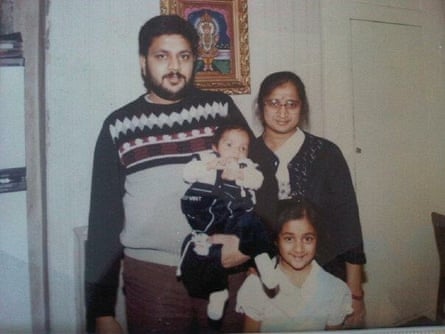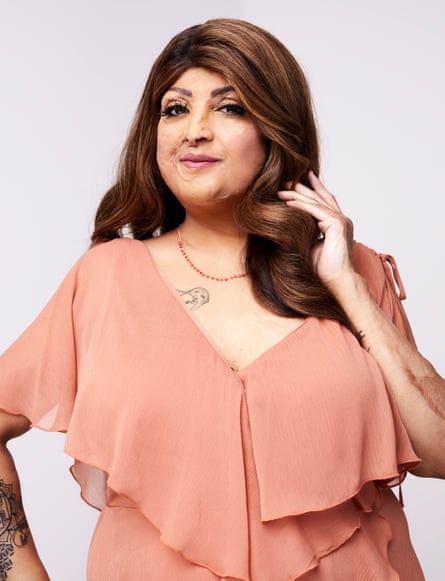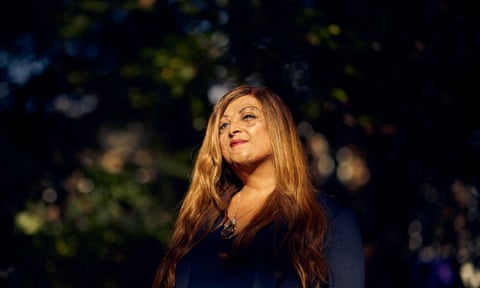Tulsi Vagjiani was 10 years old and had been in hospital for several weeks when her bandages finally came off and she asked the nurses to show her what she looked like. She had been warned that she had extensive burns, but they seemed reluctant to let her look – they asked her if she was sure. “The nurses and doctors were like: I don’t think she realises the severity of what she looks like,” says Vagjiani.
Vagjiani felt as if she had not changed, even if she was confused about what exactly had happened. “I was just Tulsi – boisterous, loud, confident.” She thought: how bad could it be? “Then I saw myself in the mirror and I was like: oh.” She says it in a quiet voice. “I actually thought somebody drew that face on, because I thought: that’s not me. And then, looking at the person in the mirror, their eyes and mouth moving, I realised: that is me.”
Vagjiani had been through an extraordinary ordeal that would eventually set her on a path to being a campaigner for those with visible differences. At 42, she is now a motivational speaker and coach, never happier than when she is giving talks in schools.
In hospital, she was told something of what had happened to her by her relatives who had visited each day: that she had been in a plane crash; that her mother, father and younger brother, Kamlesh – her only sibling – had not survived it; and that she had burns that covered nearly half of her body, including her face.
The family had been on a three‑month trip to India, her parents’ home country, before Vagjiani started secondary school. “Because we lived in London, we had it pretty good and my dad wanted us to be grateful for what we had. And it was an opportunity for him to visit his grandad, who he hadn’t seen for 23 years. So the whole idea was to do north and south India – see everything and just give us life experience.”

They had not planned to be on that plane from Mumbai to Bengaluru in February 1990 – it was a trip they were expecting to make later in the holiday, but their luggage was lost on the way from the UK. When they got a call to say it had arrived in Mumbai, the family thought they could pick it up, then go on to explore southern India.
Vagjiani’s memories of the days and weeks after the crash, in which 92 of the 146 people on board were killed, are disjointed. She remembers drifting in and out of consciousness in hospital in Bengaluru and hearing her grandmother’s voice. “My gran was very stern, didn’t show emotions. For her to be crying …” Her grandmother had travelled from the UK and Vagjiani remembers wondering whether she had arrived to surprise the family. She remembers voices – medics, or perhaps someone from the rescue team – telling her they were going to look after her. “In the midst of that, I still felt like I was fighting with my brother, who wanted to sit by the window.”
She was vaguely aware of being on a medical flight to the UK, where she was transferred to St Andrew’s, a specialist burns and plastic surgery unit in Essex. Other relatives arrived. “At least these voices were familiar. But again, I thought they were on the plane, I thought: wow, this is turning into a family holiday now.”
Vagjiani was in hospital for nearly five months, then went to live with her grandparents, on the same street as her family home. Although she says the loss of her parents was often talked about, it was not until later, when she was about 13, that “it suddenly dawned on me that they were not returning from India”. She had convinced herself that it was a mistake, that they had lost their passports and had been trying to get home all this time. “I was angry they left me behind. I was upset they took my brother and left me alone here.”
She was able to return to primary school for the last few weeks. “That was difficult, because the Tulsi they knew wasn’t the same one,” she says. “They did really well to integrate and include me in everything, but I just felt different. But I was lucky, because those handful of friends were also the ones that went to the high school with me and were in my class.”
Her secondary school was “very supportive”, she says. By the time she was 16, she had had more than 30 operations on her scars. “I made friends straight away, who are still my friends now. I had the best experience; there was no bullying.”
Outside on the streets, however, it was a different story. People would stare at her, some crossing the road to avoid her. Worse was the name‑calling. “Being surrounded by gangs of people, when I was on my own and couldn’t defend myself. Nothing physical happened, but it was the constant word torment, and really internalising that I was ‘ugly’. That word – I didn’t know what it meant until I looked it up, and I was like: ‘Is this what people think of me?’”
Boys would shout at her, saying she looked like Freddy Krueger, the killer from the 80s horror film series A Nightmare on Elm Street. “I didn’t know who he was. When I came home and told my uncle, I’ve never seen him so angry,” she says. When she found out who Krueger was, that he was “a villainous character – that’s how I saw myself. All the goodness that I was, I couldn’t see it; I couldn’t see my kind heart or the generous person that I was. I just saw myself as this bad person, ugly, and if this is how it’s going to be, how am I going to get through life?
“Also, growing up in a south Asian community, everything is body image – comparison starts from a young age, where you don’t look like that Bollywood actress. All my life, I was trying to be someone I’m not. We are designed to be ourselves, but I didn’t have that growing up.”
Starting college was difficult, because not everyone knew her story. She says it was a time of “dating and that kind of thing. So the body image stuff started coming out on a bigger scale.” She made good friends, “but I just never felt good enough”.
Applying for Saturday jobs was soul-destroying. Vagjiani loved fashion and would give her CV to shops on Oxford Street in London. “You’d literally see them throw it away. Each rejection was just another knockback.” Naturally outgoing – and studying hospitality and tourism – she applied for a job at the front desk of a hotel; they wrote back, saying, literally and brutally, “your face doesn’t fit our company”. “After that, I gave up applying,” she says.
Vagjiani became depressed, although it was not diagnosed, she says, partly because she was “too embarrassed”, but also because, “growing up in a south Asian community, the rule was ‘we don’t talk about it’, so everything was swept under the carpet: ‘Yeah, you’ve lost your family, you’ve got burns, get over it.’ I suffered in silence.”
She says there is “no timescale” with grief. “Moments will happen in your life where all of a sudden you miss that person or people. My journey has taken me, more than 30 years to accept what’s happened. Yes, my parents and brother are not here. Yes, I would have needed all that parental guidance and support, but I can’t live in a ‘what if’.”
The first time she addressed her mental health was as part of a counselling course she took at college, after studying health and social care. “We had to be very honest about how we felt, and I would skirt around that. I couldn’t write what I was feeling, because it was too embarrassing, too real; I thought they were going to laugh at me. In reality, that’s what the course needed me to do. It was amazing in that it helped me see that I had to do the work. I sort of self‑counselled and worked myself through the depression.”

Going to university, where she did a degree in health sciences, helped. Vagjiani also became a pilates instructor, which offered an appreciation for what her body could do, as opposed to how it looked. Then, just as life was going well, she became ill during her second year at university. She had renal failure and had to be treated with dialysis, while hoping for a transplant.
She got through university using a dialysis machine overnight. A donor kidney became available and the subsequent transplant appeared to go well. A few months later, though, with Vagjiani in a lot of pain, a cyst was discovered in the organ, so she had to be operated on again – and this time it was a lengthier and more complex procedure. She spent that year in and out of hospital, dealing with her body’s rejection of the kidney several times. “I was like: how am I going to get through this? And the constant reminder was: ‘You’ve been through a plane crash. You’ve been through worse.’”
The experience, however, started to change her relationship with her scars. She realised they had never stopped her doing anything – as her physical health was now doing. “It was the first time I felt like I wanted to give up, because it was so hard. That’s when I realised that, actually, having my scars hadn’t been hard work – it was my mindset, the negativity, that was hard. I think my confidence journey started from there.”
When her health improved, Vagjiani went to a meetup held by the Katie Piper Foundation – an organisation for people with burns and scars, founded by Piper, herself a survivor. “It was the first time I saw adults with burns and I realised I wasn’t on my own,” says Vagjiani. “Having someone like Katie, who has put herself out there publicly with her scars, gave me the courage that I too can put myself out there.” She started working with the charity Changing Faces, which supports those with visible differences and campaigns to give those people a voice.

Changing Faces has long been running a campaign, I Am Not Your Villain, that calls on the film industry to stop using people with scars, burns and other visible differences as a signifier that a character is monstrous or evil. For their campaign video, Vagjiani appears dressed as Holly Golightly from Breakfast at Tiffany’s. The campaign points out that only one in five people with a visible difference have seen a character who looks like them as a hero in a TV show or film.
But change is slow – scarred villains are a long-running cliche of the James Bond films, although you would think, by 2021, that things might have changed. In the latest, No Time to Die, the main villain has extensive facial scarring. “Here we are again,” says Vagjiani, with a sigh. “They’ve been called out a few times. It’s just mindless, lazy writing. You’re inciting fear by somebody looking different. Because that’s not what society considers beautiful; they’ve fed on that.”
The effect on those growing up with a visible difference, says Vagjiani, should not be underestimated. “I grew up thinking I was a bad person because I was compared to Freddy Krueger. No child should ever have to feel they’re comparative to a villainous character. They’re a good person, they have every right to live the life they want, and to work towards their dreams, not have their confidence knocked.”
Better representation in popular culture will help normalise visible difference and hopefully lead to a time when people don’t stare at Vagjiani in the street or on the tube. “These are the things I’ve got to be mindful of. I check in, as I’m putting my shoes or coat on: how am I feeling today? How am I going to deal with someone staring or talking about me? There are days where I don’t give a damn, and other days it’s: ‘Not today, I want to scream and shout at you.’” Vagjiani had not realised how much anxiety it was causing until the pandemic, when she was shielding. “It was realising I don’t have to worry about how I’m perceived; I can just be me, at home.” She knows a lot of other people with visible differences who felt the same.
Mainly – and on a good day – she says: “I’m so over the staring thing. But if we’re talking about my 13-year-old self, I want to give her that level of confidence, to say: ‘I know it’s not easy, and I know you’re in a world where it’s going to be difficult, but really make yourself confident and really own this.’ I love my scars now. I cannot imagine myself without them.”
It has taken a number of steps to get there. One day, she was helping out at a camouflage makeup session and asked to try concealer on her arm. “As the makeup was going on, I could feel myself getting tense,” she says. “I said: ‘I can’t see the colours and the textures and it’s not my arm,’ and the penny dropped: I’m done covering up.” Women, predominantly, are “conditioned to hide things – be blemish-free, flawless”.
When she met those friends at the Katie Piper Foundation, “I could see them as beautiful. When I got home, I went: ‘Hang on. You can call them beautiful and mean it – why can’t you do that for you?’ These are the kinds of conversations I would have – I’d look in the mirror and go: ‘I really like that about you.’ I think I started to take the word ‘beautiful’ and own it. I’m my version of beautiful, not what’s out there, and I’m OK with that.”
Vagjiani realised she could become what she lacked – a role model for other people in search of something different. “It’s that saying, isn’t it? ‘Remember who’s looking up at you.’” She smiles. “I think that, for me, was massive.”
